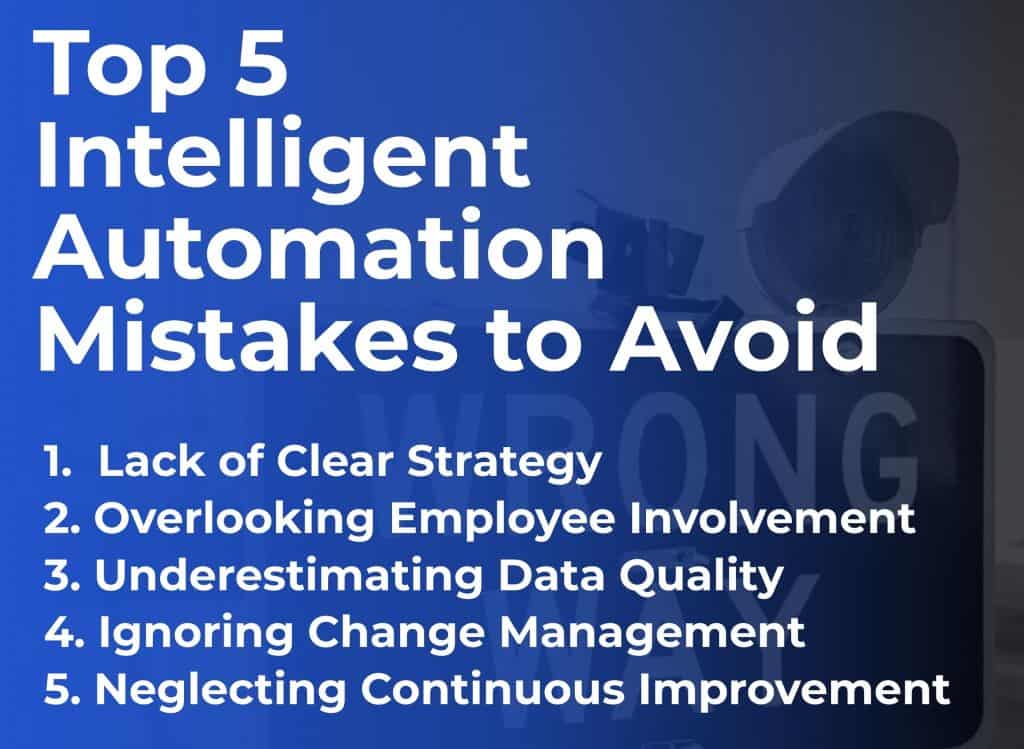Intelligent automation (IA) offers a promising avenue for enhancing efficiency and propelling innovation in today’s digital-driven business landscape. However, navigating the path to a successful IA implementation can be fraught with pitfalls. By recognizing and avoiding these common missteps, businesses can fully harness the transformative potential of IA. Let’s break down the top five missteps companies make when they jump on the IA bandwagon and how you can steer clear of them.
Lack of Clear Strategy: Charting the Course
Embarking on an intelligent automation journey without a well-defined strategy is akin to navigating treacherous waters without navigational tools. A clear strategic plan should outline your business objectives, pinpoint the processes that stand to benefit most from automation and define the metrics that will gauge success. Absent this groundwork, efforts will likely be scattered and inefficient, potentially squandering time and resources. Crafting a roadmap with specific goals and success metrics ensures your IA initiatives align with the overall business strategy.
Overlooking Employee Involvement: People at the Heart of Technology
One of the most common oversights in IA initiatives is underestimating the importance of human involvement. Automation is not just a technological upgrade but a shift that affects the entire workforce. Early employee involvement is crucial for identifying meaningful automation opportunities and ensuring that the technology meets the needs of those it’s designed to assist. Furthermore, engaging employees from the outset helps to mitigate resistance and builds a culture of innovation and adaptability, which is essential for the smooth integration of IA and Artificial Intelligence technologies into your business.
Underestimating Data Quality: The Foundation of Intelligent Automation
Here’s a simple truth: your automation is only as good as your data. This is especially important if your automations require AI and its associated training over your internal data. Neglecting the importance of accessible, clean, and unbiased data can result in inefficient processes and decision-making errors. Before implementing IA solutions, investing in data cleansing and organization is imperative. Ensuring access to clean and relevant data facilitates more accurate and efficient automation and lays the groundwork for leveraging advanced analytics and AI, amplifying the impact of automation initiatives.
Ignoring Change Management: The Human Aspect of Transformation
The introduction of IA often necessitates changes in business processes, job roles, and, potentially, the organizational culture. Overlooking the need for comprehensive change management can lead to employee resistance and project setbacks. Effective change management entails transparent communication, tailored training programs, and ongoing support, ensuring a shared understanding and buy-in across all organizational levels. By proactively managing the transition, businesses can foster a supportive environment that embraces technological advancement and change.
Neglecting Continuous Improvement: The Path to Perpetual Innovation
Viewing IA as a one-off project rather than a continuous journey is a significant misjudgment. The technological landscape is perpetually evolving, and maintaining the relevance and effectiveness of IA solutions requires ongoing attention and adaptation. Continuous improvement, driven by regular automation performance reviews and feedback loops, ensures that IA efforts meet their objectives and remain aligned with your business strategy and industry developments. This review and realignment process enhances operational efficiency and fosters a culture of innovation and resilience.
Conclusion: The Road to Intelligent Automation Success
Successfully implementing intelligent automation is a complex, multifaceted endeavor that significantly benefits those who navigate it thoughtfully. By developing a clear strategy, engaging employees, prioritizing data quality, managing change effectively, and committing to continuous improvement, businesses can avoid many common pitfalls and unlock the full potential of IA within their organizations. This strategic approach ensures that intelligent automation catalyzes growth, innovation, and competitive advantage instead of ending up as a costly misadventure that burns time, money, and morale.
Are you prepared to embark on a transformative journey with intelligent automation? By avoiding these pitfalls and adopting a measured, inclusive approach, your business can achieve new heights of efficiency and innovation. Let’s discuss how we can partner to harness the power of intelligent automation to propel your business forward.
